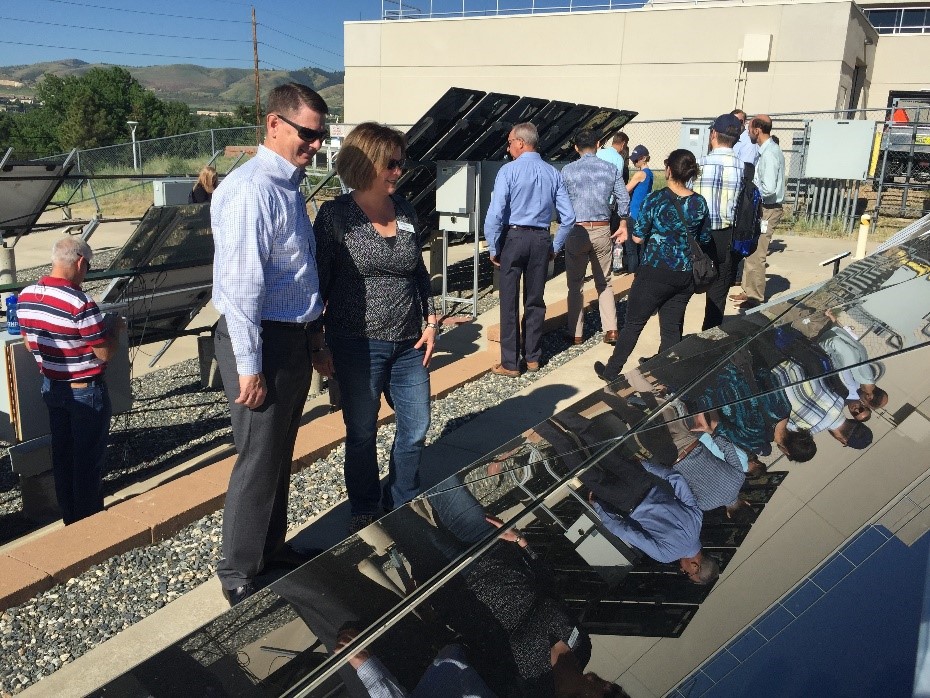
Pennsylvania’s Grid-Scale Solar Future: Siting, Evaluating, and Elevating Southwestern Pennsylvania’s Solar Impact
This project primarily focused on locating financially and environmentally feasible sites for grid-scale solar installations within Southwestern Pennsylvania to help the DEP reach their goal of 10% of the state’s electricity be generated from in-state solar by 2030.
Currently the solar energy capacity is 0.25%. Through geospatial analysis, the team located 3,771 potential sites within the nine-county region in SW PA. Of these potential sites, 243 of them were 250 acres or larger, making them suitable for grid-scale consideration. In order to assess the financial feasibility of potential sites identified through the geospatial analysis, the team created an interactive financial model.
By 2030 PA has to generate 10 to 12 gigawatts more solar energy and the 29 identified feasible sites would allow Pennsylvania to gain 1,509 MW in solar generation capacity and avoid 2.51 tons of GHG emissions. Presentations include: May 3, 2019 -Green Building United’s Sustainability Symposium in Philadelphia, PA at the Navy Yard. A panel with Duquesne Light, the PA PUC, and the DEP; Energypath, sponsored by The Pennsylvania Sustainable Energy Fund (SEF) at DeSales University on July 25, 2019.
Project Update
During the 2018 fall semester, a team of five students worked with Siefken to understand the needs and implications of wide-spread grid-scale solar deployment in southwestern Pennsylvania. The team was able to identify many financially and environmentally feasible sites for the deployment of grid-scale solar in Southwestern Pennsylvania (SW PA). Through geospatial analysis, our team located 3,771 potential sites within the nine-county region in SW PA. Of these potential sites, 243 of them were 250 acres or larger, making them suitable for grid-scale consideration. Our team ran the 243 sites through our financial model and identified 29 sites that are financially feasible for grid-scale deployment. We believe that more sites will be deemed feasible once additional criteria are inserted into the model.
Prior to performing the geospatial (GIS) analysis, the team first identified a siting criterion that outlined the desired characteristics of the ideal site for grid-scale deployment. The siting criteria was corroborated by several stakeholders within the solar energy industry to ensure its validity. Once verified, the team collected datasets that corresponded to each criterion to aid in the geospatial analysis.
In order to assess the financial feasibility of potential sites identified through the geospatial analysis, the team created an interactive financial model. The financial model was created with the help of online tools and industry stakeholders. To assess the positive environmental impact that these feasible sites could have, we calculated the total avoided greenhouse gas (GHG) emissions.
In terms of impact, if the 29 identified feasible sites were deployed, Pennsylvania would gain 1,509 MW in solar generation capacity and avoid 2.51 tons of GHG emissions.
Upon using the siting criteria to perform the geospatial (GIS) analysis, our team initially identified 3,771 potential sites for grid-scale deployment. To verify that these potential sites were not located in greenfields, which are sites that have never been developed, our team used Google Earth and other online mapping applications. During this verification process, we found that greenfields were, in fact, being identified as potential sites for solar deployment. Most of the greenfields included forested areas, state game lands, golf courses, country clubs, and cemeteries.
Subsequently, our next steps entail collecting datasets for these types of greenfields to ensure that greenfields will no longer be identified as potential sites. We also plan to collect data for slope, which was one siting set of criteria that was not utilized during the fall 2018 semester.
Project Team
Anna J. Siefken
Executive Director, The Wilton E. Scott Institute for Energy Innovation
Rick Stafford
Service Professor of Public Policy, Heinz College of Information Systems and Public Policy, Metro21 Fellow
